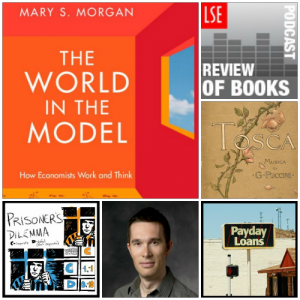 During the last two centuries, economic science has become a social science based on mathematical models in place of words. In this book Mary S. Morgan approaches this change – both historically and philosophically – using a series of case studies to illuminate its nature and the implications. This reconnection of economics with the economies it studies could be of interest to those looking to reform the teaching of economics, writes Jennifer Miller.
During the last two centuries, economic science has become a social science based on mathematical models in place of words. In this book Mary S. Morgan approaches this change – both historically and philosophically – using a series of case studies to illuminate its nature and the implications. This reconnection of economics with the economies it studies could be of interest to those looking to reform the teaching of economics, writes Jennifer Miller.
 The World in the Model: How Economists Work and Think. Mary S. Morgan. Cambridge University Press. September 2012.
The World in the Model: How Economists Work and Think. Mary S. Morgan. Cambridge University Press. September 2012.
Recently, The Economist and the Financial Times have profiled an initiative, led by Wendy Carlin and sponsored by the Institute for New Economic Thinking, to reshape the economics curriculum. The initiative, known as coreecon, uses the tagline “teaching economics as if the last three decades had happened.” The initiative is a response to concerns from teachers, students, employers, and others that economists failed to anticipate, prevent, or respond effectively to the global economic crisis. They are especially concerned that the economics curriculum has spiraled into an arms race of applied mathematics disconnected from reality, while failing to expose students to the most current thinking.
Faced with the opportunity to review The World in the Model: How Economists Work and Think by Mary S. Morgan (London School of Economics and University of Amsterdam), I wondered what this book might offer to those looking to reform the teaching of economics. Morgan offers “a series of historical case studies” of some of the most influential models in economics accompanied by philosophical commentary on the changing role of models over the past 200 years.
In presenting the models as historical case studies, Morgan contributes to one of the objectives of the coreecon reforms, reconnecting economics with the economies it studies. Morgan argues that modeling has largely supplanted earlier economic approaches based on theories and laws. She finds that economists use models in two ways: to explore economic phenomena within the model and to explore the real world the model is intended to represent. It is with this aspect of the argument that the book may have the most to offer to critics of prevailing ideas in economics education. In working with models, economists may lose sight of the limitations of models for each of these purposes or fail to differentiate their claims about the model world and claims about the real world.
Morgan traces the history of modeling in economics, from novel use of models by Quesnay, Ricardo, and von Thunen in the early 19th century to late 19th century models like the Edgeworth box, Marshall’s early trade diagrams, and a physical, hydraulic model of the economy built by Fisher. By the late 19th century, Morgan finds that models had emerged as the predominant form of economic reasoning. She offers a typology of four distinct varieties of models: recipes, idealizations, visualizations, and analogies.
Reviewing the book over the Thanksgiving holiday, my attention was particularly drawn to the idea of economic models as recipes, a characterization attributed to Marcel Boumans. The recipe model is exemplified by the model farm Ricardo used to understand distribution of economic gains among labourers, farmers, and landlords in an agricultural economy. The ingredients of Ricardo’s model included definitions, concepts, and assumptions as well as empirical elements from contemporary agricultural experiments. A system of accounts similar to that used by farmers themselves provided a degree of mathematical formalism as well as a flexible structure in which Ricardo could conduct virtual experiments in model farming.
The case study of Ricardo’s model farm was thought-provoking in three ways. First, it showed how physical science, in the form of agricultural experiments, was used to inform even these early agricultural models. Second, the case highlighted the relevance of economists’ practical experience. Ricardo was a participant in this agricultural economy, not just an observer. What does it mean that today’s economists are fairly isolated in academia, finance, and government? Third, Ricardo was in fact engaged in something of a response to economic crisis in his own local context. The newly imposed Corn Laws placed the working class at the mercy of trade policy, while the Poor Laws placed responsibility on landowners like Ricardo for the wellbeing of the poor and destitute within their parish.
After a series of case studies including a natural history of homo economicus and a discussion of the Prisoners’ Dilemma with reference to the Puccini opera Tosca (for more see the LSE Review of Books podcast on Finance and Economics), Morgan offers some concluding thoughts. She observes that influential models can play a variety of roles in economics, as “keystones, stitches, conceptual resources, logos, exemplars, or flexible travelers.” Rather than following an identifiable pattern, the process through which models take on these roles seems to be historically path dependent.
With reference to the familiar London Tube map, she offers an insightful analogy about how economists’ models may lead them astray. Some users of the Tube, accustomed to navigating with the linear map, find themselves disoriented when attempting to navigate the true urban geography of London. Such may be the case when economists, accustomed to their models, attempt to navigate the real economy in its messy complexity.
While this book is a compilation of narrative case studies, I’d be remiss if I failed to point out that it is no Freakanomics-style romp through the history of economics. While there are illustrations, even the occasional colour photo or cartoon, there are also reproductions of primary documents, data tables, and complex graphs accompanied by fairly dense philosophical commentary. The book is reminiscent of Kuhn’s Structure of Scientific Revolutions. It’s recommended to those willing to invest some effort into exploring the historical context around the models that populate introductory economics textbooks.
…………………………………………………………………………………………………………………..
Episode 7: Behind Economics and Finance: Prisoners’ Dilemmas and Payday Loans
[jwplayer file=”http://media.rawvoice.com/lse_lsereviewofbooksblog/richmedia.lse.ac.uk/lsereviewofbooksblog/20130717_LSERB_Podcast_7_behindEconomicsAndFinance.mp3″]
![]() Download MP3
Download MP3 ![]() Listen + Subscribe via iTunes
Listen + Subscribe via iTunes ![]() Webfeed
Webfeed

Mary Morgan, LSE Professor of History and Philosophy of Economics, speaks to us about her book The World in the Model: How Economists Work and Think and how the once prose-heavy discipline founded by Adam Smith has been transformed by maths and modelling.
Carl Packman, author of Loan Sharks: The Rise and Rise of Payday Lending, discusses the exponential growth of the payday lending industry in the UK.
Director of LSE’s Centre for Economic Performance, Professor John van Reenen, thinks back to his early career and identifies the books that shaped his thinking about the economic world.
Presented by Amy Mollett. Produced by Cheryl Brumley. Other Contributors: Mary Morgan, Carl Packman, John van Reenen, Joel Suss. Music and sound came courtesy of the following users at freesound.org: wim (London underground train arriving 6 and 13), Foop (Edithouse); and The FreeMusicArchive.org: Dumbo Gets Mad (Radical Leap), Podington Bear (Dark Matter, Light in Branches, Pink Blossoms, Light Touch), Deltason (Groundloop). Collage photo: Photo: Payday Loan (Thomas Hawk) and Prisoner’s Dilemma Guila.Forsythe via Flickr. Published 17th July 2013.
…………………………………………………………………………………………………………………..
Jennifer Miller is an Assistant Teaching Professor at the University of Southern California’s Sol Price School of Public Policy. She received her doctorate in public policy from the University of North Carolina at Chapel Hill. Her research interests focus on the scientific workforce. She has also written about collaboration among universities, industry, and government in university research centres. Before pursuing her doctorate, she worked for IBM in human resources. Read more reviews by Jennifer.








4 Comments